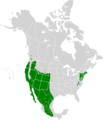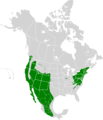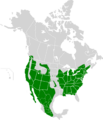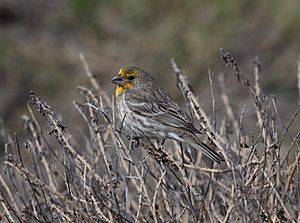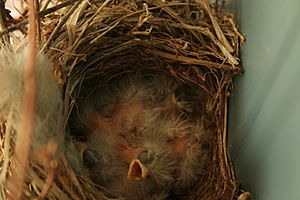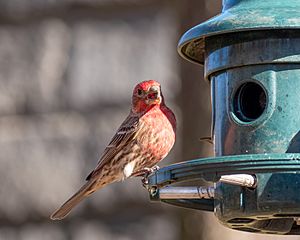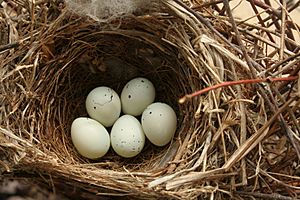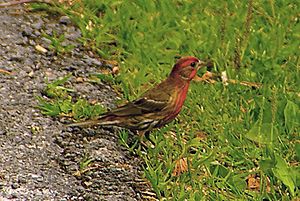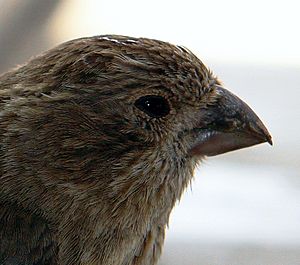House finch facts for kids
Quick facts for kids House finch |
|
|---|---|
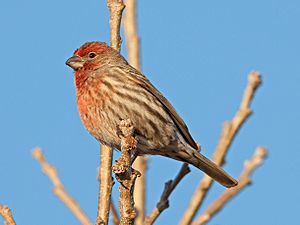 |
|
| Adult male | |
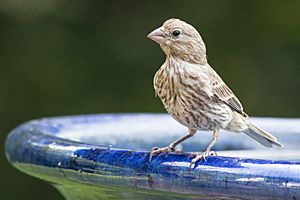 |
|
| Adult female | |
| Conservation status | |
| Scientific classification | |
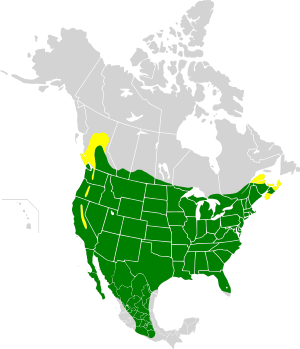 |
|
| Range of H. mexicanus Breeding range Year-round range | |
| Synonyms | |
|
The house finch (Haemorhous mexicanus) is a small bird that belongs to the finch family. These birds are originally from western North America. However, they have also been brought to the eastern parts of the continent and to Hawaii. The house finch and other similar "American rosefinches" are part of the Haemorhous group of birds.
Contents
What They Look Like
The house finch is a medium-sized finch. Adult birds are about 12.5 to 15 centimeters (5 to 6 inches) long. Their wings can spread out about 20 to 25 centimeters (8 to 10 inches) wide. They usually weigh around 21 grams (about 0.75 ounces).
Adult house finches have a long, brown tail that looks square at the end. Their backs are brown or dull brown. Their wing feathers are a deep gray. You might see streaks on their chest and belly feathers.
Most adult males have red heads, necks, and shoulders. This red color can sometimes spread to their belly and back. The brightness of the male's red color changes with the seasons. It depends on the berries and fruits they eat. So, their colors can be anything from pale yellow or bright orange (which are rare) to a deep, bright red. Adult females are brown on top and have streaked feathers underneath.
Their song sounds like a fast, happy warble. They also make a variety of chirping sounds.
Bird Family Tree
This bird is in the group called Haemorhous. The purple finch and Cassin's finch are also in this group. Even though they look similar, these three species are not closely related to the "Old World" rosefinches. Those birds are found in other parts of the world.
Where They Live and Grow
House finches usually stay in the same area all year round. However, some birds from northern and eastern areas will migrate south for winter. They like to live in cities and suburbs across North America. You can also find them in open areas in the west, from southern Canada down to Mexico.
House finches were originally only found in Mexico and the southwestern United States. But in the 1940s, they were brought to eastern North America. People in New York City illegally sold them as "Hollywood Finches." To avoid getting in trouble with the law, sellers and owners let the birds go. Since then, these birds have made themselves at home. In many treeless areas of the eastern U.S., they have taken over from the native purple finch. They have even replaced the non-native house sparrow. In the 1870s, house finches were also brought to Hawaii. Now, they are very common on all the main islands there.
It is thought that there are anywhere from 267 million to 1.7 billion house finches across North America.
How House Finch Areas Grew (from Bird Counts)
What They Eat
House finches usually look for food on the ground or in plants. They mostly eat grains, seeds, and berries. They love to eat weed seeds, like those from nettle and dandelion plants. Sometimes, they also eat small insects like aphids by accident.
These birds often visit bird feeders all year. They especially like feeders with sunflower or nyjer seeds. You will often see them gathered at hanging nyjer sock feeders. House finches are known to sometimes eat fruit from orchards. They can also eat grain grown by farmers. But usually, they are seen as a small problem, not a big one.
Reproduction and Life Cycle
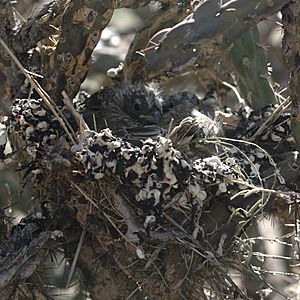
House finches build their nests in holes or openings. This includes spaces in buildings, hanging plants, and other outdoor decorations. Sometimes, they use nests that other birds have left behind. They might even use the same nest for new babies or in the next year. The female bird builds the nest, sometimes in just two days. She makes a strong, cup-shaped nest from twigs and other bits. It is usually about 1.8 to 2.7 meters (6 to 9 feet) off the ground.
When a male and female are getting ready to mate, the male will touch bills with the female. He might then offer her tasty bits of food. If she acts like a hungry baby bird, he might actually feed her. The male also feeds the female while she is laying eggs, sitting on them, and raising the young. The male is the main one who feeds the young birds after they leave the nest. You can tell these young birds from females by the small, new feathers still on their heads. Female finches are usually more attracted to males with the brightest red heads.
The female lays eggs from February through August. She can have two or more groups of babies each year. Each group usually has 2 to 6 eggs, most often 4 or 5. She usually lays one egg per day in the morning. The eggs are a pale bluish-green with a few black spots. They feel smooth and look a bit shiny.
If there are mites in the nest, which can hurt male chicks more than females, the mother finch might lay female eggs first. This helps to make sure that enough male chicks survive. The female sits on the eggs for 12 to 14 days to keep them warm. Soon after the eggs hatch, she takes the empty shells out of the nest. The baby birds are pink, with their eyes closed, and have soft, fluffy down feathers. The female always feeds the young, and the male usually helps too. The young birds are quiet for the first week or so. After that, they start peeping when they are fed. Before they can fly, the young birds often climb into nearby plants. They usually fly away from the nest about 11 to 19 days after hatching. Dandelion seeds are a favorite food for feeding the young. Unlike most birds, even those that eat plants as adults, house finches feed their young only plant matter. This is unusual because most baby birds need animal protein to grow.
House finches can be quite bossy. They are known to chase other birds away from places like feeders.
Health Challenges
House finches can get sick from different tiny living things called parasites. One type of sickness caused their population in eastern North America to drop a lot in the 1990s.
Tiny bugs called mites are often found on house finch babies, especially in nests later in the season.
The brown-headed cowbird is a "brood parasite." This means it lays its eggs in other birds' nests. Brown-headed cowbirds will lay their eggs in house finch nests. However, the plant-based diet that house finches feed their young is not good enough for baby cowbirds. Because of this, young cowbirds rarely survive in a house finch nest.
Images for kids
See also
 In Spanish: Camachuelo mexicano para niños
In Spanish: Camachuelo mexicano para niños




